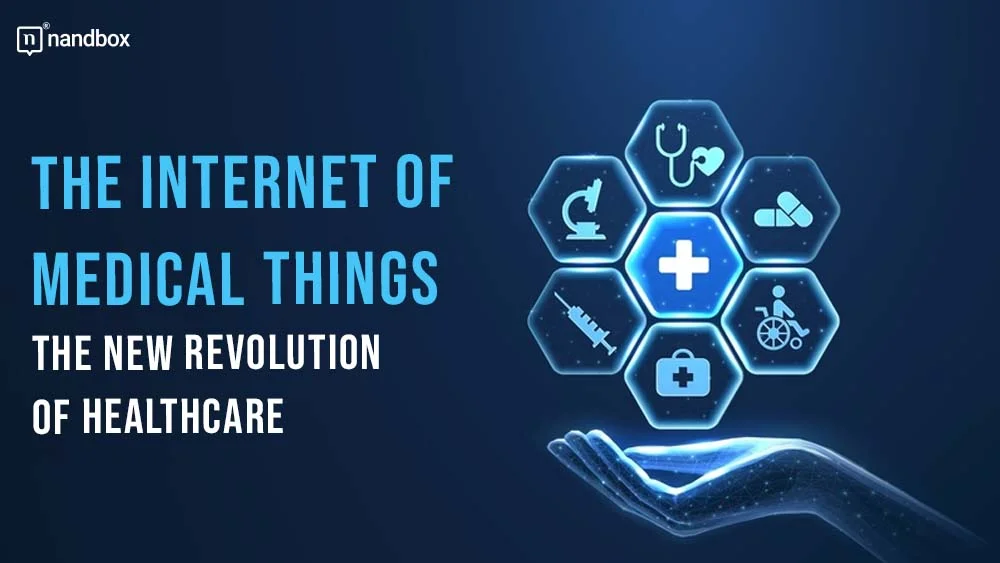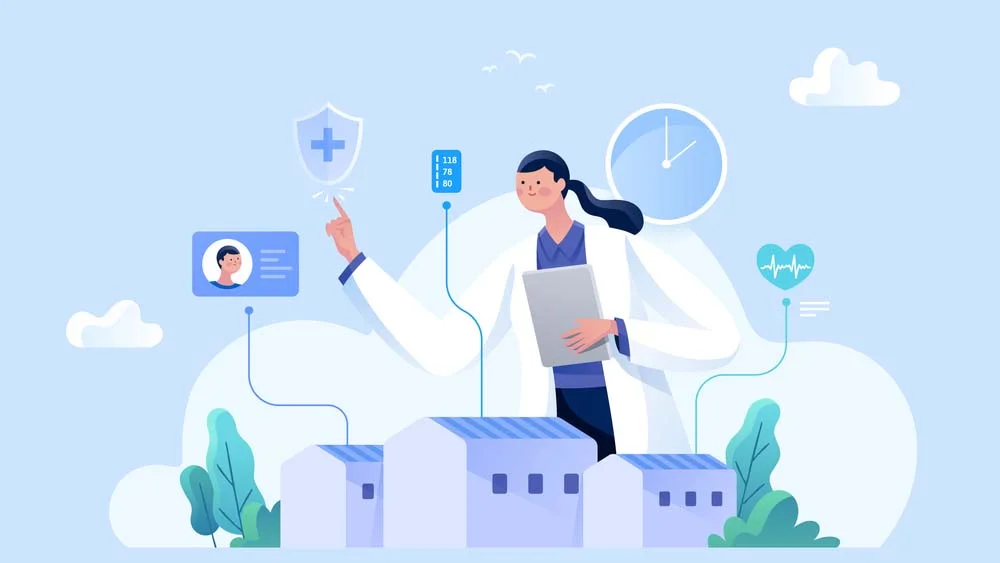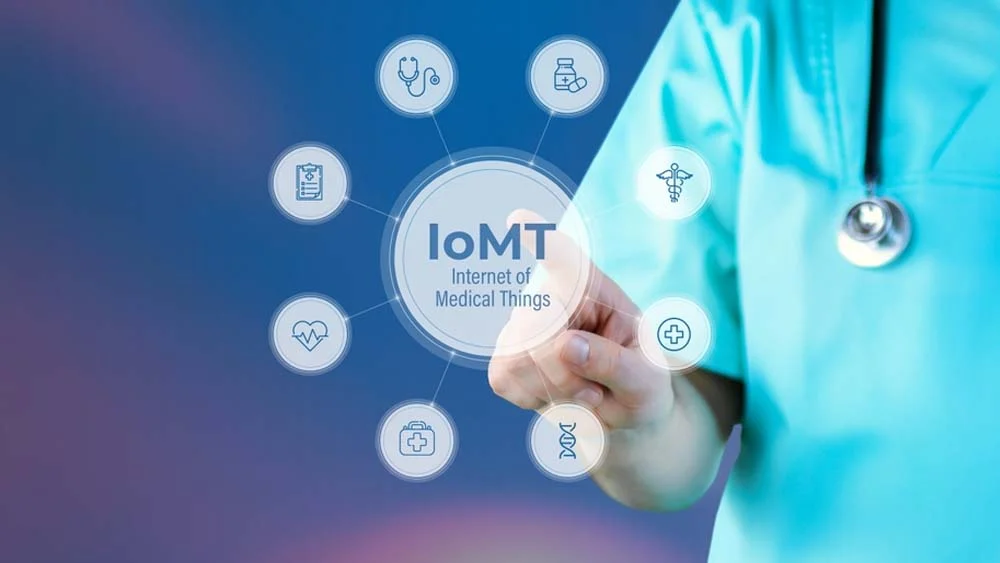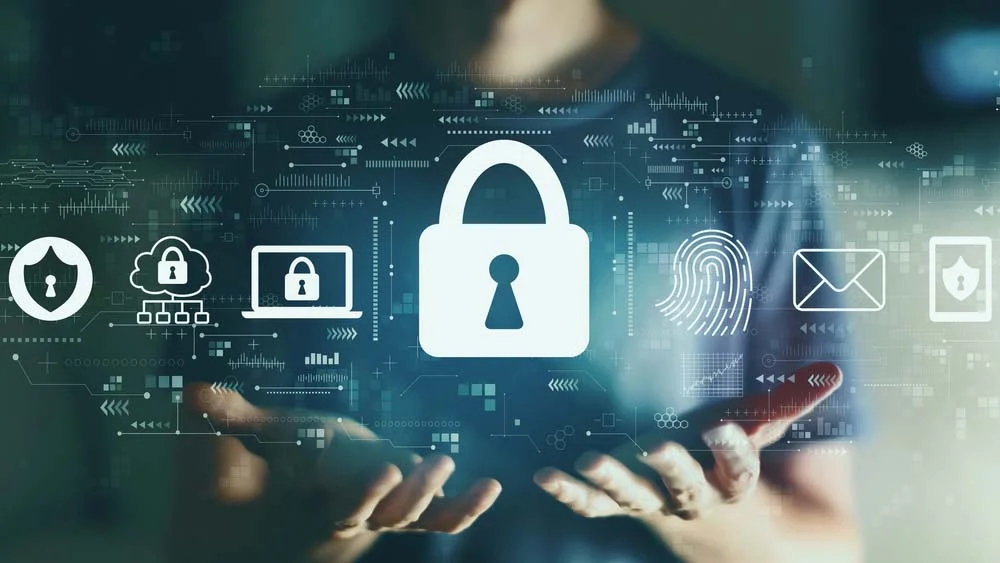Health is every human’s priority and basic need. With every emerging technology, new device, and tech trend, experts tend to take advantage of them for the sake of healthcare. This helps the healthcare sector prosper and be one of the most dynamic and ever-evolving sectors ever. In recent years, the healthcare sector has been witnessing an exceptional transformation. This is especially true with technologies like artificial intelligence, automation, and robotics. However, one technology has contributed significantly to this transformation and caused one of the best mergers in this sector. This technology is the Internet of Medical Things.
A new era in patient care, diagnosis, and medical management has begun thanks to the innovative convergence of healthcare and technology, also known as the “IoMT” or the “Internet of Medical Things.” In this article, we will explore the rise of the exceptional Internet of Medical Things. We will dive deep into the origins of this merger, its importance, challenges, and types of IoMT devices.
What Is the Internet of Things?
The Internet of Things, or IoT, is a vast system in which plenty of devices are interconnected to provide users with enhanced features. Using sensors and other means, such as smart chips, an unprecedented number of devices can sync how they operate in real time. This high level of connectivity enables the exchange of data between devices, improving their functionality. The devices communicate via internet-connected data centers, with data validation and analysis taking place in the cloud. These networks and data centers allow connected devices to share information about their users, including their orders, preferences, behavior, and so on.
The New Extension of IoT: IoMT
IoT emerged with an exceptional concept and technology behind it. Many sectors and industries rushed to incorporate it in many aspects and parts of institutions. For instance, IoT helped establish the idea of smart cities where all devices and gadgets are connected. Additionally, they also made an appearance in the retail industry with many capabilities. For instance, contact and frictionless payments, as well as smart sensors for inventory management.
Since the healthcare sector is known for always adapting emerging technologies, the same happened with IoT. And indeed, it was a very effective adoption. IoMT is the implementation of interconnectivity in medical devices. This includes giving medical devices like monitors the ability to communicate and exchange data with one another to enhance all operations and functions.
The goal of these devices is to collect, transmit, and exchange data that can be used to better care for patients, streamline healthcare operations, and strengthen the healthcare ecosystem as a whole.
How Is IoMT Impacting the Healthcare Sector?
The way that IoMT is impacting the health sector is outstanding. During the pandemic in 2020, it all started. The healthcare sector then was the knight in shining armor that aided millions of people around the world. It was then highlighted how badly the world needed the interference and capabilities of new technologies that help improve this industry to the fullest.
It was referred to as IoT as a new and emerging technology, as well as holding very great potential. IoT successfully achieved and offered capabilities like remote monitoring, disease management, and remote accessibility to health services. The healthcare sector was desperate and very in need. IoMT then came to light as a novel part of the health sector, in addition to many technologies and tools like applications.
For instance, one of the biggest impacts of IoMT is streamlining healthcare processes. With IoMT, data collection and transmission can be automated, which significantly lessens administrative workloads. Services like dental credentialing services offer similar benefits for dental professionals, ensuring the process becomes efficient. As a result, healthcare operations become more streamlined, resources are better allocated, and overhead is cut.
The Benefits of IoMT
The Internet of Medical Things (IoMT) offers a wide range of benefits in healthcare, both for patients and healthcare providers. Some of the key advantages of IoMT include:
Improved Patient Care and Outcomes
IoMT devices allow for continuous monitoring of patient’s vital signs, which allows for early diagnosis of health problems and prompt treatment. This may increase the standard of care provided to patients.
Remote Monitoring
With IoMT, medical staff can keep tabs on patients without having to physically check in on them as often. Patients with long-term illnesses or those who reside in remote regions can benefit greatly from this.
Enhanced Efficiency
The use of IoMT has the potential to increase the effectiveness of healthcare facilities by streamlining procedures, decreasing formalities, and lowering costs. The result is reduced expenditures and a more efficient use of resources.
Personalized Medicine
With the help of IoMT data, medical care can be personalized for each patient by attending to their unique medical history and current conditions. This has the potential to improve the quality and individualization of healthcare. This can be useful to online psychiatrists as well, who can leverage this personalized data to offer tailored mental health treatments and support, enhancing the overall effectiveness of psychiatric care
Preventive Care and Faster Diagnosis
When it comes to diseases, IoMT devices can pick up on early warning signs and risk factors, allowing for precautionary measures and lifestyle adjustments to be made before the condition worsens. Since it is known for emphasizing remote diagnosis, specialists can consult on cases without physically being present. This leads to faster and more accurate diagnoses.
Data-Driven Decision Making
The Internet of Medical Things creates a huge amount of information that can be mined for insights via analytics, ML, and AI. The information gathered here can be used to better tailor care, guide future studies, and shape healthcare policies.
Reduced Healthcare Costs
IoMT has the potential to significantly cut healthcare costs by lowering hospital readmission rates, expanding access to preventative services, and increasing overall system efficiency. This is done through medical billing modules, and extremely expensive treatments like those in the field of neurology are being handled effectively while reducing their cost through neurology medical billing modules.
Improved Patient Experience
The patient’s healthcare experience can vastly improve if they are given more say over their health. They would also have more access to their health data and more involvement in their care plans.
Research and Innovation
Data from IoMT can contribute to medical research and innovation. This can speed up the process of creating new treatments, medical devices, and pharmaceuticals.
Top IoMT Devices That You Should Know About
Implantable Medical Devices
Implantable medical devices are a great category that is now used for many diseases. These devices help patients to a great extent, especially those with chronic illnesses that might be life-threatening in some cases. They are implanted into a patient’s body part, either partly or fully, and have different functions that vary from one device to another. For instance, there are insulin pumps, which are regulated through applications usually. They help people with diabetes with their insulin intake throughout the day, as they can detect low levels of insulin and take orders to instantly push out a certain dosage.
Smart Inhalers
Smart inhalers are invaluable tools for all asthma patients. They are designed to improve the management of respiratory conditions and improve their conditions. These devices are equipped with sensors and connectivity features. They allow for better medication management and monitoring of a patient’s inhaler usage. For instance, To help patients remember to take their medication, smart inhalers can alert them just before it’s time to do so. Typically, these notifications are sent through connected and specific mobile apps. Additionally, these devices keep track of and store extensive data relating to inhaler use. When and how many times an inhaler was used, how many puffs were taken, and whether or not a dose was skipped are all recorded here.
Smart Pills
The latest innovation in IoMT is smart pills. Smart pills are expected to achieve remarkable results in the field of medical research and diagnosis. Smart pills are a form of medical device that incorporates microchips into medication. This is to monitor and transmit data about a patient’s health. They go by a variety of names, including digital pills and ingestible sensors. The minute smart pills are digested by a patient, they can report and send minute information about the patient’s wellbeing. As well as make accurate diagnoses based on the collected data.
Challenges of IoMT
While the Internet of Medical Things (IoMT) offers significant benefits in healthcare, it also comes with several challenges and considerations, including:
Data Privacy and Security
Because of the sensitive nature of the patient data they collect and transmit, IoMT devices are a prime target for cyberattacks. For the sake of patient confidentiality and to forestall data breaches, it is crucial to ensure strong data encryption, authentication, and cybersecurity measures.
Interoperability
There is no standardization of connectivity or data format among IoMT devices because they are all made by different companies. It can be difficult to ensure that all healthcare devices and systems can communicate and share data without any difficulties.
Scalability
Healthcare organizations will need to increase their capacity to manage data and devices as IoMT becomes more widely adopted. This can put a strain on the current IT infrastructure and necessitate substantial new expenditure.
Reliability
The availability and consistency of IoMT infrastructure are critical in the medical field. Since they need to be always available. Access to healthcare services and safety can be compromised if these devices experience downtime or malfunction.
Data Overload
IoMT devices generate an enormous amount of data, which can be a burden for healthcare providers. Making sense of this data and determining what needs to be done first requires the creation of efficient data analytics and decision support systems.
Cost and Implementation Challenges
The time and money required to implement solutions for IoMT are significant obstacles. Smaller healthcare facilities may have limited resources and fewer staff members with technical expertise.
Education and Training
For IoMT devices to be used and the data they generate to be properly interpreted, healthcare professionals need proper training. It may be difficult to ensure they are adequately skilled since the technical side would be advanced and a bit difficult to comprehend.
En Fin
A new era in healthcare has arrived, greeted by the growth of the internet of medical things. When medical expertise and advanced technology come together like this, it can completely transform how we assess and treat patients. Improvements in both patient satisfaction and health outcomes can be attributed to IoMT’s capacity to facilitate remote monitoring, accurate diagnoses, individualized care plans, and efficient healthcare operations. The potential for IoMT to improve healthcare in terms of cost, efficiency, and focus on the needs of individual patients is enormous as the field continues to develop and grow.
A more open, data-driven, and empowered healthcare system is in the making thanks to the internet of medical thing’s profound impacts. Adopting IoMT is not just a step forward in terms of technology, but also a pledge to provide higher-quality, more cost-effective healthcare to all people. IoMT is a force that promises to drive good change and improve the way we care for ourselves and each other.






